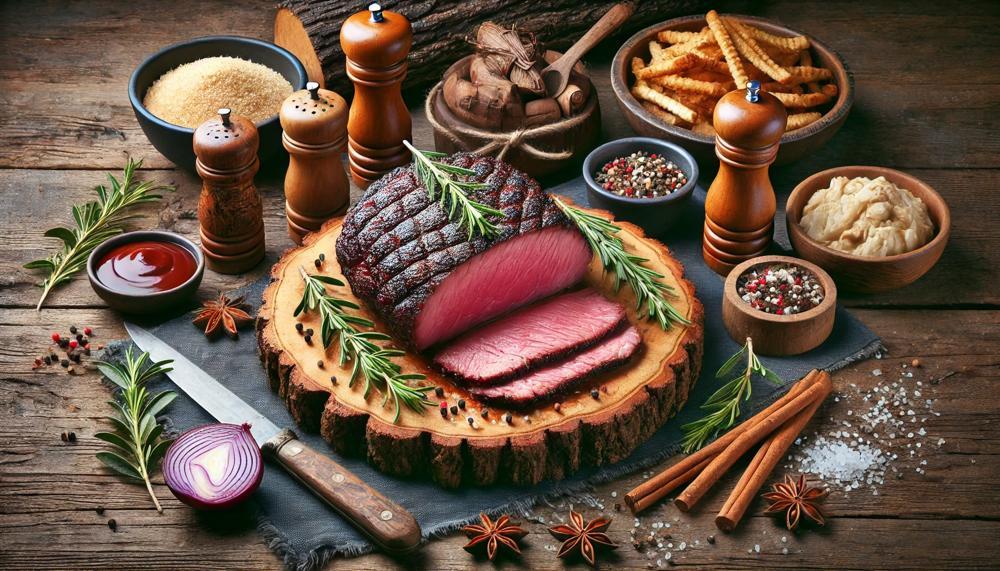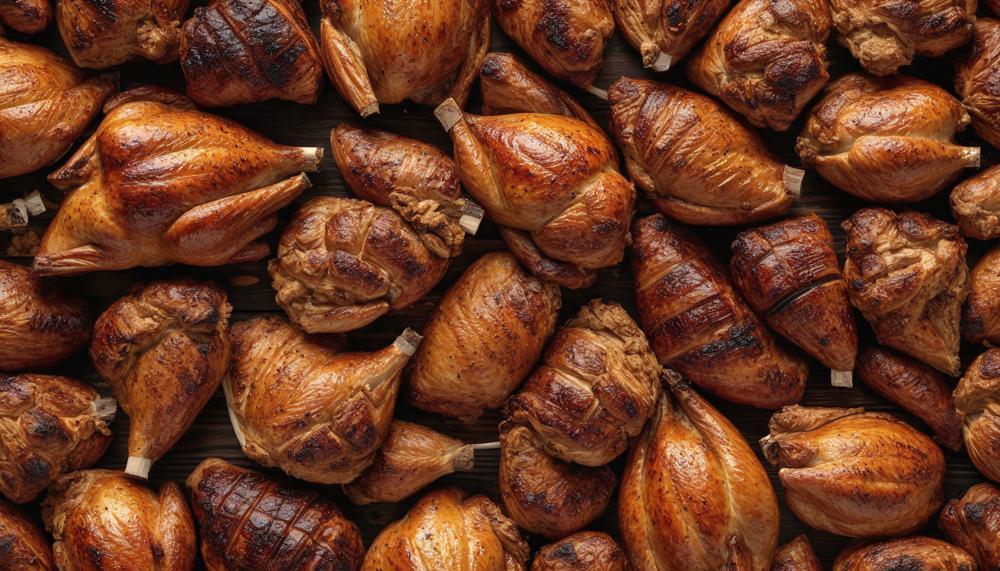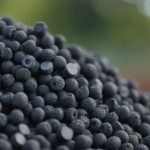Yes, the choice of wood can significantly impact the flavor of your smoked beef roast. Different woods offer varying intensities and flavors that can either enhance or detract from the natural taste of the meat.
For beef roasts, hickory stands out as an excellent option due to its robust and strong flavor profile, which complements the bold flavors of beef beautifully.
Key Takeaways:
- Wood Selection: Hickory is best for beef due to its intense flavor.
- Matching Intensity: Ensure the wood’s smoke intensity aligns with the robustness of the beef.
- Enhanced Flavor: Proper wood selection enhances the natural richness of the beef roast.
Choosing the right wood for smoking is crucial to achieving a flavorful and well-balanced beef roast. Now, let’s dive into why hickory is the top choice and how to maximize its potential when smoking your next roast.
Hickory
The primary taste profile includes a robust, bacon-like smokiness with earthy undertones. This distinct flavor profile is often associated with classic Southern barbecue and is particularly suited to the rich, hearty flavors of beef.
Detailed Flavor Breakdown:
| Flavor | Description |
| Strong | Powerful smoke that infuses deeply into the meat |
| Bacony | Reminiscent of smoked bacon, adding a savory, umami quality |
| Earthy | Grounded, natural tones that accentuate the beef’s intrinsic flavors |
Hickory wood, with its bold and assertive smoke profile, is particularly effective in enhancing the inherent flavors of beef. It is this intensity that ensures the meat does not just absorb smoke but melds the flavors to create a characteristically rich, savory experience that is both satisfying and mouth-watering.
Oak
Oak wood imparts a distinctive array of flavors to a beef roast, setting it apart with its hearty, rich, and full-bodied smoke profile. This wood is particularly valued for its ability to enhance the natural flavors of the meat without overwhelming it. When used for smoking, oak contributes a smooth yet robust taste, offering a subtle sweetness paired with earthy undertones that enrich the beef’s inherent savory qualities.
Here’s how oak influences the beef roast during the smoking process:
| Flavor Aspect | Description | Effect on Beef |
| Hearty and Full-bodied | Rounded, robust flavor that permeates the meat. | Creates a satisfying depth, enhancing the beef’s natural richness. |
| Richness | Adds a layer of complexity with its lush smoke profile. | Augments the juicy, full flavors inherent in a well-marbled roast. |
| Subtle Sweetness | Underlying sweet notes that balance the smoke’s intensity. | Complements the umami and savory elements of the beef. |
| Earthy Undertones | Mild, grounding earthiness that anchors the stronger flavors. | Harmonizes with beef’s meaty notes for a grounded taste experience. |
Oak’s unique ability to meld these flavors while smoking makes it a superb choice for those who cherish a nuanced culinary experience, especially in grilling scenarios. This wood ensures that every slice of beef roast is not just cooked but transformed into a delectably smoky delight that’s both enriching and memorable.
Pecan
Pecan wood imparts a sweet, nutty flavour with a hint of spice when used to smoke a beef roast. Unlike milder fruit woods such as apple, pecan offers a more pronounced intensity that complements the richness of beef without overshadowing its natural flavours.
Its medium intensity strikes a balance, enhancing the meat with a delightful sweetness and a subtle kick of spice, creating a memorable smoky profile that’s perfect for beef roasts.
| Flavor Profile | Sweet, nutty | Hint of spice |
| Intensity | Medium | Not overpowering |
| Best Pairings | Beef roasts | Complements without overshadowing |
Apple
The choice of wood in smoking a beef roast is crucial as it contributes significantly to the flavor profile of the meat. Different woods impart distinct flavors, transforming the taste experience of the roast.
For instance, apple wood offers a mild, sweet fruitiness, which complements the robust nature of beef without dominating its flavor.
On the other hand, hickory provides a stronger, more assertive smoky taste, which is perfect for those who enjoy a hearty smoky flavor.
Below is a table summarizing the effects of various woods on the flavor profile of smoked beef roast:
| Wood Type | Flavor Profile | Suitability for Beef |
| Apple | Mild and sweet | Best for a subtle sweetness |
| Hickory | Strong and smoky | Great for a robust smoky taste |
| Mesquite | Intense and earthy | Ideal for short smoking times due to its strength |
| Pecan | Sweet and nutty with a hint of spice | Excellent for enhancing beef without overpowering |
| Cherry | Sweet and fruity | Good for adding a light, sweet smoke flavor |
The selection of wood should align with your desired flavor outcome. For a more nuanced and tender smoky taste, apple or cherry wood is recommendable. If a bold, prominent smoky flavor is what you’re after, hickory or mesquite would be more appropriate.
Understanding these nuances allows for a tailored smoking experience, enhancing the natural flavors of the beef roast while introducing delightful smoky undertones.
Mesquite
When smoking a beef roast using mesquite wood, the imparted flavors are distinctively intense, earthy, and subtly sweet.
Mesquite’s robust aroma seeps deeply into the meat, creating a rich, full-bodied smoky taste. This makes it particularly well-suited for enhancing the natural flavors of denser, gamey meats like beef.

Detailed Flavor Profile:
| Flavor Aspect | Description |
| Intensity | Mesquite smoke is potent and assertive, ideal for those who appreciate a hearty smoky flavor. |
| Character | The flavors are earthy, providing a rustic taste that complements the natural richness of beef. |
| Sweetness | There’s a subtle sweetness behind the powerful smoky notes, adding a complex layer to the roast’s overall flavor. |
Conclusion
In the quest to master the art of smoking a beef roast, the selection of wood plays a pivotal role in flavoring the meat. Hickory, with its robust, bacon-like smokiness, and earthy undertones, reigns supreme for those seeking a hearty, smoky flavor. This wood’s intense aroma infuses the beef, enhancing its natural richness and complementing its bold flavors superbly.
On the other hand, oak offers a full-bodied smoke with a subtle sweetness and rich earthy notes, making it ideal for those who appreciate a nuanced smoke profile without overpowering the meat. Oak’s ability to meld with the beef’s flavors ensures each slice is not just cooked, but transformed into a delectably smoky delight.
For a slightly different twist, pecan provides a medium-intensity smoke that strikes a perfect balance between enhancing the meat’s flavor and maintaining its natural taste. Its sweet, nutty, and slightly spicy notes offer a unique flavor profile that makes the beef roast memorable.
Whether you prefer the strong, distinctive taste of hickory or the more balanced and rich flavors of oak and pecan, choosing the right wood is about matching the smoke’s character to your personal taste preferences. Each type of wood brings its own unique essence to the table, transforming a simple beef roast into an exquisite culinary masterpiece.






